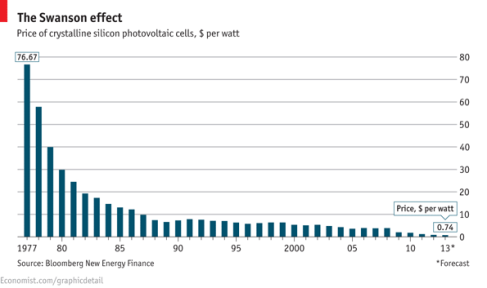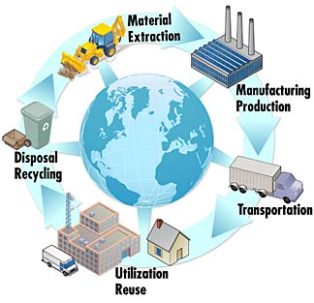Solar energy is currently perceived as one of a host of renewable technologies that serve as a beacon of hope in the upcoming switch from carbon-based energy production. While it may not currently have the presence in the U.S. that wind power has attained, the cost of producing a solar panel has dropped significantly even since the early 2000s [1].
Similar to Moore’s Law, the Swanson effect predicts the decrease in solar energy cost over time [1].
However, as this push for the commercialization of solar energy becomes both more urgent and more imminent, it is essential that the negative impact of this technology be evaluated and managed over the panel’s lifespan.
Life cycle of a solar panel [2].
This life cycle continues all the way to the eventual disposal or recycling of the product [2]. Throughout it, both the manufacturer and the end user must take responsibility for the pollution and waste that they generate.
Manufacturing of solar panels, like the production of most electronic products, requires the use of a variety of harmful chemicals such as hydrofluoric acid and kerf dust, a byproduct of silicon wafer production [3]. On top of these, fossil fuels are consumed in the acquisition of raw materials and the production of the cells [4]. California reports that from 2007 to 2011 more than 46.5 million pounds of hazardous waste was created by solar panel manufacturers within the state alone [5]. With manufacturing increasing in China and less governmental regulation, these materials are being improperly dumped into the environment [6].
As the price of electricity rises, residents in sunny locales have begun to look to solar power to provide electricity. However, at the end of the panel’s lifespan, it is important that individuals have the ability to properly dispose of them. While this may not play as significant a role as the manufacturing of the panels, if these panels are simply sent to a landfill, serious potential health risks arise from the ability of the lead soldier in the panels to contaminate the local soil and groundwater [3]. Other materials, such as glass and aluminum, could also be recycled reducing the need for new raw material sources [3]. At the moment, manufacturers have complete autonomy over solar panel recycling [7], however, the creation of industry-wide regulation is necessary to manage the waste at all stages in the solar panel life cycle.
Solar energy may currently be a renewable energy source, but in order to become a sustainable one a combination of both governmental regulation and public education needs to take place. Demanding accountability for pollution and waste created throughout the existence of a solar panel is the best way to secure a future that could possibly be entirely solar powered [4].
[1] http://www.economist.com/blogs/graphicdetail/2012/12/daily-chart-19
[2] http://livingworkinggreen.wordpress.com/2011/04/05/life-cycle-impact-of-solar-goes-beyond-hot-water/
[3] http://www.oregon.gov/odot/hwy/oipp/docs/life-cyclehealthandsafetyconcerns.pdf
[4] http://www.scientificamerican.com/article.cfm?id=solar-cells-prove-cleaner-way-to-produce-power





